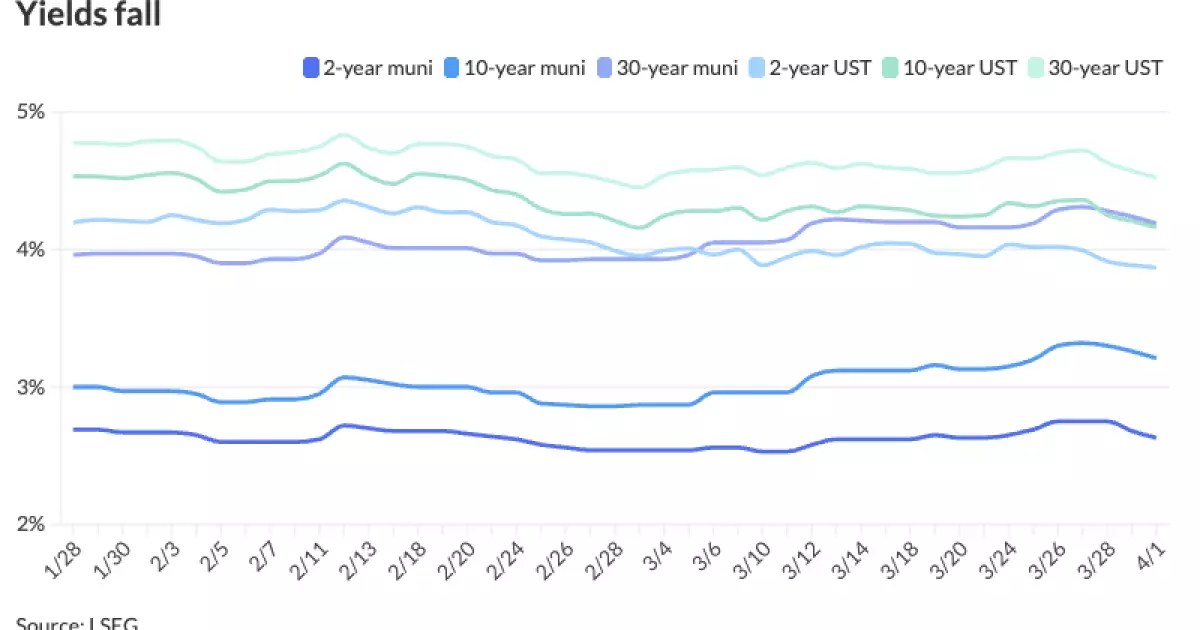The municipal bond market has recently come under intense scrutiny, reflecting larger financial narratives that are shaping the current economic environment. A slew of factors has contributed to a notable decline in demand, entwined with supply dynamics and prevailing macroeconomic uncertainties. As the Trump administration prepares to unveil additional tariffs, investors are left grappling with how these political machinations will influence municipal bond yields. The figures are staggering: a 14.5% year-over-year increase in supply juxtaposed with a negative demand for three consecutive weeks. Such statistics spell trouble for what was once a stable investment choice. They resonate with the growing sentiment of risk that is permeating the financial landscape.
Daryl Clements, a municipal portfolio manager at AllianceBernstein, warns of the strange relationship that ensues when munis become too cheap. They often rally—when, however, is the million-dollar question. It’s clear that as yields have recently dipped—AAA MMD yields falling five to twelve basis points over the previous week—investors are left wondering if this is a beneficial dip or a siren call leading to more significant issues ahead.
A Market Awash with Red Flags
The current mood in the municipal market is marked by a palpable tension. Analysts from J.P. Morgan have flagged this week as an opportunity filled with potential volatility—a forecasting exercise that is increasingly becoming common in today’s uncertain climate. With several imminent events, including the anticipated tariff implementation and significant upcoming economic data releases like the nonfarm payroll report, it seems the market is gearing up for more than just minor fluctuations.
The looming uncertainties amplify fears of additional market instability. J.P. Morgan has predicted that around $9.3 billion in estimated supply could further strain market conditions, demonstrating how precarious the situation is. This raises critical questions regarding just how resilient munis can remain in the face of policy shifts and external pressures when upcoming redemptions point towards an anticipated lull in May. The concern here is not merely operational; it’s symptomatic of a much larger national economy teetering on the edge.
Redemptions and Their Insidious Impact
If April represents a time of relative quiet in the municipal bond landscape, May promises a resurgence in reinvestment capital—pending, of course, on how the active players in our economic narrative decide to proceed. Pat Luby of CreditSights outlines an alarming trend: April’s expected redemptions are set to be around 28% lower month-over-month, sparking fears that this could mask broader market fragility. With the allure of a higher return often tempting investors, the actual underpinnings of the market seem weaker than they portray.
Investors must remain vigilant as they think about the implications of these low redemption amounts. Will market confidence sustain as we shift into a season characterized by increased capital? Or will the supposed influx become yet another mirage, revealing a disconnection between market sentiment and reality? The prevailing view through a center-right liberal lens posits that the overarching narrative of the political economy may ultimately outweigh traditional market indicators.
The Bigger Picture: Tariffs and Reinvestment Capital
The impending tariffs are not merely a blip on the financial radar; they are a game-changer that could fundamentally alter the landscape for municipal securities. The possibility of heightened tariffs has historically prompted uncertainty, shaking the foundations of sectors closely tied to state revenues and, consequently, municipal bonds. How can bond investors afford to feel secure when the very policies that bipartisan coalitions once championed seem ripe for upheaval?
Investing on the backbone of political stability is at the heart of responsible financial stewardship, and the coming months will test this principle vigorously. As April gives way to May, the anticipated reinvestment capital must be handled with the utmost caution. If investors perceive impending economic conditions as unstable, they may withdraw from the municipal landscape entirely, leading to a self-fulfilling prophecy of lower demand.
Forecasting the Future: Where to Next?
In a market where the stakes are continually raised, understanding the ebb and flow of trends becomes paramount. The question prospective investors must face is simple yet profound: is the municipal market a reliable refuge in times of political and economic upheaval? As yields fluctuate under the pressure of market conditions, there is an inherent risk that appears to overshadow the potential rewards.
The reality is that municipalities will continue to rely on these bonds to fund critical infrastructure while investors weighed down by uncertainty navigate a turbulent market landscape. How these elements resolve in the coming months will shape investor strategies, public policy, and ultimately, the welfare of communities that depend on robust municipal funding. Such contemplations provide food for thought in an environment marked by complexity and volatility.


Leave a Reply